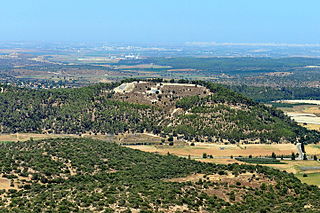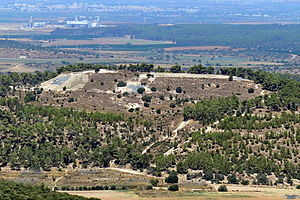
The history of ancient Israel and Judah spans from the early appearance of the Israelites in Canaan's hill country during the late second millennium BCE, to the establishment and subsequent downfall of the two Israelite kingdoms in the mid-first millennium BCE. This history unfolds within the Southern Levant during the Iron Age. The earliest documented mention of "Israel" as a people appears on the Merneptah Stele, an ancient Egyptian inscription dating back to around 1208 BCE. Archaeological evidence suggests that ancient Israelite culture evolved from the pre-existing Canaanite civilization. During the Iron Age II period, two Israelite kingdoms emerged, covering much of Canaan: the Kingdom of Israel in the north and the Kingdom of Judah in the south.

The Kingdom of Judah was an Israelite kingdom of the Southern Levant during the Iron Age. Centered in the highlands to the west of the Dead Sea, the kingdom's capital was Jerusalem. It was ruled by the Davidic line for four centuries. Jews are named after Judah, and primarily descend from people who lived in the region.

The Israelites were a Hebrew-speaking ethnoreligious group consisting of tribes that inhabited much of Canaan during the Iron Age.

The Babylonian captivity or Babylonian exile was the period in Jewish history during which a large number of Judeans from the ancient Kingdom of Judah were forcibly relocated to Babylonia by the Neo-Babylonian Empire. The deportations occurred in multiple waves: After the siege of Jerusalem in 597 BCE, around 7,000 individuals were deported to Mesopotamia. Further deportations followed the destruction of Jerusalem and Solomon's Temple in 587 BCE.

Lachish was an ancient Israelite city in the Shephelah region of Canaan on the south bank of the Lakhish River mentioned several times in the Hebrew Bible. The current tell by that name, known as Tel Lachish or Tell el-Duweir, has been identified with Lachish. Today, it is an Israeli national park operated and maintained by the Israel Nature and Parks Authority. It lies near the present-day moshav of Lakhish, which was named in honor of the ancient city.

Israel Finkelstein is an Israeli archaeologist, professor emeritus at Tel Aviv University and the head of the School of Archaeology and Maritime Cultures at the University of Haifa. Finkelstein is active in the archaeology of the Levant and is an applicant of archaeological data in reconstructing biblical history. Finkelstein is the current excavator of Megiddo, a key site for the study of the Bronze and Iron Ages in the Levant.

Azekah was an ancient town in the Shephela guarding the upper reaches of the Valley of Elah, about 26 km (16 mi) northwest of Hebron.

The LMLK seal appears on the handles of several large storage jars from the Kingdom of Judah, where it was first issued during the reign of Hezekiah around 700 BCE. Seals bearing these four Hebrew letters have been discovered primarily on unearthed artifacts in and around Jerusalem, with some in northern Israel. Several complete jars were found in situ at the ancient city of Lachish, where they were buried underneath a destruction layer caused by Sennacherib, who reigned over the Neo-Assyrian Empire from 705 BCE to 681 BCE. While none of the original stamp seals have been found, some 2,000 impressions made by at least 21 seal types have been published. The iconography of the two- and four-winged symbols are representative of royal symbols whose meaning "was tailored in each kingdom to the local religion and ideology".

Tel Arad or Tell 'Arad is an archaeological tell, or mound, located west of the Dead Sea, about 10 kilometres west of the modern Israeli city of Arad in an area surrounded by mountain ridges which is known as the Arad Plain. The site is about 10.1 ha.

Ramat Rachel or Ramat Raḥel is a kibbutz located in central Israel. An enclave within Jerusalem's municipal boundaries, near the neighborhoods Arnona and Talpiot, and overlooking Bethlehem and Rachel's Tomb, it falls under the jurisdiction of Mateh Yehuda Regional Council. In 2022, it had a population of 550.

Khirbet Qeiyafa, also known as Elah Fortress and in Hebrew as Horbat Qayafa, is the site of an ancient fortress city overlooking the Valley of Elah and dated to the first half of the 10th century BCE. The ruins of the fortress were uncovered in 2007, near the Israeli city of Beit Shemesh, 30 km (20 mi) from Jerusalem. It covers nearly 2.3 ha and is encircled by a 700-meter-long (2,300 ft) city wall constructed of field stones, some weighing up to eight tons. Excavations at site continued in subsequent years. A number of archaeologists, mainly the two excavators, Yosef Garfinkel and Saar Ganor, have claimed that it might be one of two biblical cities, either Sha'arayim, whose name they interpret as "Two Gates", because of the two gates discovered on the site, or Neta'im; and that the large structure at the center is an administrative building dating to the reign of King David, where he might have lodged at some point. This is based on their conclusions that the site dates to the early Iron IIA, ca. 1025–975 BCE, a range which includes the biblical date for the biblical Kingdom of David. Others suggest it might represent either a North Israelite, Philistine, or Canaanite fortress, a claim rejected by the archaeological team that excavated the site. The team's conclusion that Khirbet Qeiyafa was a fortress of King David has been criticised by some scholars. Garfinkel (2017) changed the chronology of Khirbet Qeiyafa to ca. 1000–975 BCE.

The siege of Jerusalem was the final event of the Judahite revolts against Babylon, in which Nebuchadnezzar II, king of the Neo-Babylonian Empire, besieged Jerusalem, the capital city of the Kingdom of Judah. Jerusalem fell after a 30-month siege, following which the Babylonians systematically destroyed the city and Solomon's Temple. The Kingdom of Judah was dissolved and many of its inhabitants exiled to Babylon.

The return to Zion is an event recorded in Ezra–Nehemiah of the Hebrew Bible, in which the Jews of the Kingdom of Judah—subjugated by the Neo-Babylonian Empire—were freed from the Babylonian captivity following the Persian conquest of Babylon. In 539 BCE, the Persian king Cyrus the Great issued the Edict of Cyrus allowing the Jews to return to Jerusalem and the Land of Judah, which was made a self-governing Jewish province under the new Persian Empire.

Yehud Medinata, also called Yehud Medinta or simply Yehud, was an autonomous province of the Achaemenid Empire. Located in Judea, the territory was distinctly Jewish, with the High Priest of Israel emerging as a central religious and political leader. It lasted for just over two centuries before being incorporated into the Hellenistic empires, which emerged following the Greek conquest of the Persian Empire.
Yehud was a province of the Neo-Babylonian Empire established in the former territories of the Kingdom of Judah, which was destroyed by the Babylonians in the aftermath of the Judahite revolts and the siege of Jerusalem in 587/6 BCE. It first existed as a Jewish administrative division under Gedaliah ben Aḥikam, who was later assassinated by a fellow Jew. The Fast of Gedaliah, a minor fast day in Judaism, was established in memory of this event, and is lamented by observant Jews even to this day.

Jacob L. Wright is a biblical scholar currently serving as professor of Hebrew Bible at Emory University. Prior to his Emory appointment, Wright taught at the University of Heidelberg (Germany), one of the foremost research-oriented public universities in Europe, for several years. His areas of expertise include Biblical Archaeology, warfare in the Ancient Near East, and the literary and redaction history of the Hebrew Bible canon. He has published extensively throughout his career, authoring several books and dozens of articles which span topics such as Ezra-Nehemiah, the Persian period, warfare in the Ancient Near East; as well as the material culture of the ancient Levant, the unique role of women in the Hebrew Bible, and larger themes such as defeat, peoplehood, and national identity in the Hebrew Bible. Areas of concentration in war studies include war commemoration, urbicide and ritual violence, and feasting and gift-giving.
Matthew J. Adams is an archaeologist who specializes in the Near East. He earned his degrees at Pennsylvania State University and the University of California, Los Angeles. He served as the director of the Albright Institute of Archaeological Research in Jerusalem (2014–2022), and is the current president of American Archaeology Abroad, Inc. He has worked on several archaeological projects in the past, and is currently director of the Jezreel Valley Regional Project, Co-Director of the Megiddo Expedition along with Israel Finkelstein and Mario Martin, and co-director of the Solomon's Pools Archaeological Project with Mark Letteney.

Tel Yarmuth or Khirbet Yarmuk is an ancient Near East archaeological site in Israel located 25 kilometers southwest of Jerusalem and near modern Beit Shemesh. It is a large primarily single-period site and has been suggested as possibly being the city of Jarmuth, being only a tentative identification, as it is based solely on the similarity of the Hebrew name with the Arabic name and its areal location.

Nadav Na'aman is an Israeli archaeologist and historian. He specializes in the study of the Near East in the second and first millenniums BCE. His research combines the history of the Ancient Near East, archaeology, Assyrology, and the study of the Hebrew Bible. He possesses broad knowledge in all these four branches of research.
The Sonia and Marco Nadler Institute of Archaeology, known also as Tel Aviv University Institute of Archaeology, is a research facility at the Lester and Sally Entin Faculty of Humanities. Founded in 1968 by Yohanan Aharoni, the institute sponsors interdisciplinary and international fieldwork and research projects on ancient human societies of the Ancient Near East and the Mediterranean Sea. Fieldwork includes archaeological excavation and survey in key sites scattered all over Israel from prehistoric, biblical and classical periods. It is currently headed by Yuval Gadot.


















